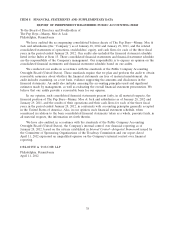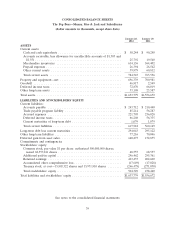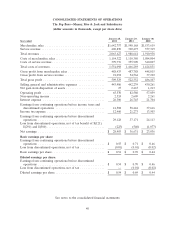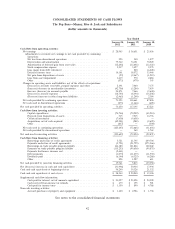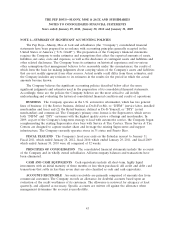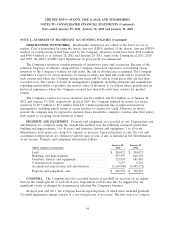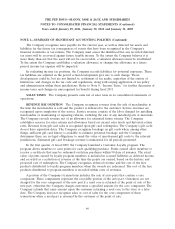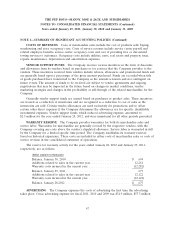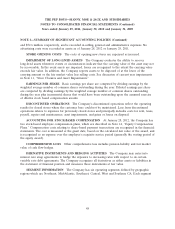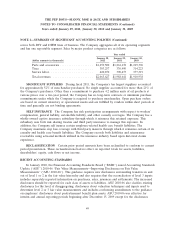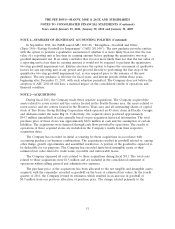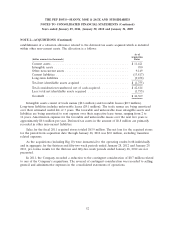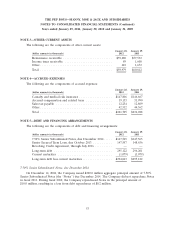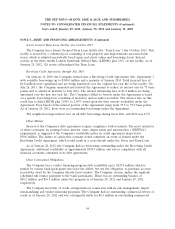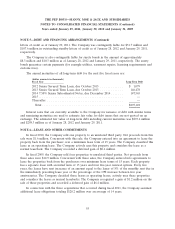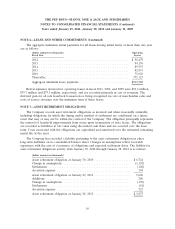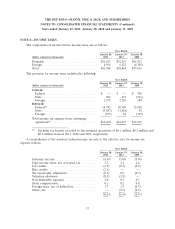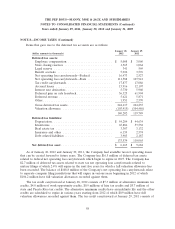Pep Boys 2011 Annual Report Download - page 92
Download and view the complete annual report
Please find page 92 of the 2011 Pep Boys annual report below. You can navigate through the pages in the report by either clicking on the pages listed below, or by using the keyword search tool below to find specific information within the annual report.THE PEP BOYS—MANNY, MOE & JACK AND SUBSIDIARIES
NOTES TO CONSOLIDATED FINANCIAL STATEMENTS (Continued)
Years ended January 29, 2011, January 30, 2010 and January 31, 2009
NOTE 1—SUMMARY OF SIGNIFICANT ACCOUNTING POLICIES (Continued)
and $52.6 million, respectively, and is recorded in selling, general and administrative expenses. No
advertising costs were recorded as assets as of January 28, 2012 or January 29, 2011.
STORE OPENING COSTS The costs of opening new stores are expensed as incurred.
IMPAIRMENT OF LONG-LIVED ASSETS The Company evaluates the ability to recover
long-lived assets whenever events or circumstances indicate that the carrying value of the asset may not
be recoverable. In the event assets are impaired, losses are recognized to the extent the carrying value
exceeds fair value. In addition, the Company reports assets to be disposed of at the lower of the
carrying amount or the fair market value less selling costs. See discussion of current year impairments
in Note 11, ‘‘Store Closures and Asset Impairments.’’
EARNINGS PER SHARE Basic earnings per share are computed by dividing earnings by the
weighted average number of common shares outstanding during the year. Diluted earnings per share
are computed by dividing earnings by the weighted average number of common shares outstanding
during the year plus incremental shares that would have been outstanding upon the assumed exercise
of dilutive stock based compensation awards.
DISCONTINUED OPERATIONS The Company’s discontinued operations reflect the operating
results for closed stores where the customer base could not be maintained. Loss from discontinued
operations relates to expenses for previously closed stores and principally includes costs for rent, taxes,
payroll, repairs and maintenance, asset impairments, and gains or losses on disposal.
ACCOUNTING FOR STOCK-BASED COMPENSATION At January 28, 2012, the Company has
two stock-based employee compensation plans, which are described in Note 14, ‘‘Equity Compensation
Plans.’’ Compensation costs relating to share-based payment transactions are recognized in the financial
statements. The cost is measured at the grant date, based on the calculated fair value of the award, and
is recognized as an expense over the employee’s requisite service period (generally the vesting period of
the equity award).
COMPREHENSIVE LOSS Other comprehensive loss includes pension liability and fair market
value of cash flow hedges.
DERIVATIVE INSTRUMENTS AND HEDGING ACTIVITIES The Company may enter into
interest rate swap agreements to hedge the exposure to increasing rates with respect to its certain
variable rate debt agreements. The Company recognizes all derivatives as either assets or liabilities in
the statement of financial position and measures those instruments at fair value.
SEGMENT INFORMATION The Company has six operating segments defined by geographic
regions which are Northeast, Mid-Atlantic, Southeast, Central, West and Southern CA. Each segment
48


